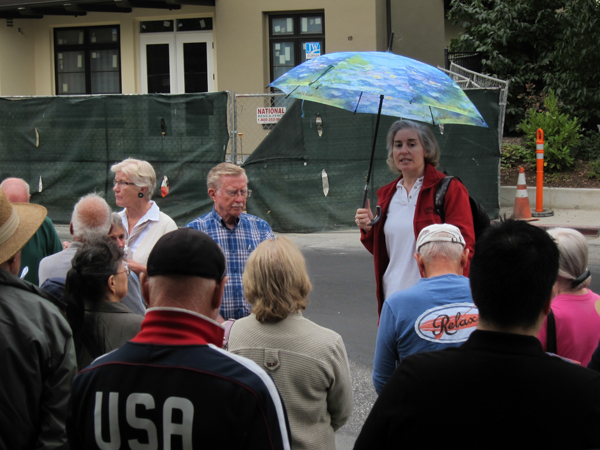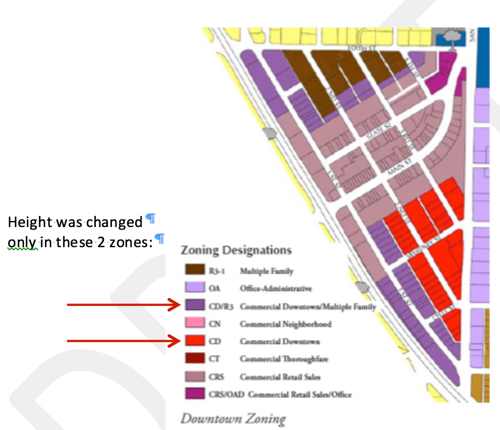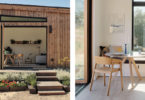Lalahpolitico: This is an opinion piece authored by Pat Marriott, member of the Downtown Buildings Committee. The council members’ voting records were clarified in a March 6 update below.
First Street Canyon
– the creation

Author: Pat Marriott was a member of the Downtown Buildings Committee. You can email her at patmarriott@sbcglobal.net
In 2014, residents – as well as some PTC commissioners and council members – were unpleasantly surprised by new development downtown. The Downtown Buildings Committee was formed to fix that.
Zoning changes in 2010 increased height limits in the CD and CD/R3 zones to 45 feet. Resulting buildings, including the 43-foot tall Safeway and a condo on the north end of First Street that peaked at 57 feet, turned First Street into a dark canyon.
Tall buildings created shadows on the narrow street. Minimum setbacks and cramped sidewalks diminished the pedestrian experience. Here is the north end of First Street mid-February, about 3:30 pm.
CANYON SHADOWS 2018 PHOTO GALLERY:
CLICK ON top image, magnifying glass, for a LARGE image carousel of the shadows
Where were the Heights Lowered?
CD and CD/R3
Figure 1: Downtown Triangle Zoning Map
Genesis of the Downtown Buildings Committee
In the summer of 2014, then Mayor and Council member Megan Satterlee initiated a series of downtown walking tours to gather residents’ opinions on recent development.
In October 2014, Satterlee recommended the formation of an ad hoc City Council committee “to determine next steps to ensure new buildings downtown meet community expectations.”
The Downtown Buildings Committee (DBC) was formed in March 2015 with ten volunteer residents selected by Council. Satterlee became a non-voting member who facilitated, but did not direct, proceedings.

2014, Mayor Megan Satterlee with umbrella leading the “canyon” tour. Condos topping at 57 feet at “tower elements” are not quite finished in the background on First Street.
City Council directed the Downtown Buildings Committee to review recently-completed buildings in the context of zoning code, Downtown Design Guidelines and the Downtown Design Plan. Two resident surveys regarding downtown (2012 and 2014-15) were reviewed.
Figure 2: From 2015 Godbe Downtown Planning Survey presentation

Rank of recent buildings downtown from most to least liked: Packard Foundation, Safeway, Enchante Hotel, 400 Main [Cetrella/Thoits Law], Charles Schwab, 100 First St. Mediterranean style condos, 396 First St. Lennar condos.
Downtown Buildings Committee members spent thousands of person-hours of studying Los Altos documents and related documents from other cities. They interviewed residents, architects and developers, as well as officials in neighboring communities.
All 24 meetings were noticed and open to the public. Recommendations were reviewed by the Planning & Transportation Commission (PTC). Three study sessions were held with Council prior to the formal Council presentation. Links to meetings, reports and presentation here:
https://www.losaltosca.gov/citycouncil/page/downtown-buildings-committee-12.
Downtown Buildings Committee Goal: No more surprises for residents
The Downtown Buildings Committee charter was specific. Members were asked to determine
- WHY people were surprised by new developments (reflected in DBC Findings)
- HOW the city could ensure predictability and transparency in future development to meet community expectations (specified in DBC Recommendations).
Overall, the objective was to expedite the development process, making it smoother and more equitable for all stakeholders, while resulting in quality projects to enhance our downtown.
Downtown Buildings Committee Findings: Too many surprises
- The most visible and contentious issues had to do with buildings’ height, bulk and mass:
- The maximum allowed building envelope increased 200 – 300% after 2010 zoning changes.
- City zoning language and guidelines were outdated and insufficient.
- Taller buildings with minimum setbacks on narrow streets created shadowy canyons. (Figure 3)
- The city had moved from Floor Area Ratio (FAR) zoning, which defines lot coverage and floor area limits, to a form-based approach that is “less prescriptive,” i.e., easier to get around the rules. This “flexibility” (including exceptions to code and tradeoffs for so-called public benefits) – demanded by developers and approved by staff and city officials – produced buildings that did not satisfy community expectations.
Figure 3: Ratio of building height to street width. Representative cross-sections at maximum build-out

Frst Street , Second Street and Third Street, running roughly N and S are more narrow than Main Street and State Street, which run roughtly east – west. Hence the shadowy canyon effect on First Street.
- Related factors included building design elements (articulation) and materials, setbacks and landscaping:
- Pedestrian experience and human scale were negatively affected by insufficient articulation.
- Narrow sidewalks compromised pedestrian comfort and safety.
- Landscaping requirements were inconsistent and lacked enforcement.
- Guidelines for quality of materials were inadequate.
- What we saw (in developers’ plans and staff reports) isn’t necessarily what we got:
- Existing planning tools and project submittal requirements lagged current technology.
- Decision-makers – and residents – lacked tools to visualize proposed development.
- To ensure transparency and fairness, documentation and process needed significant improvement:
- City documents lacked consistency and coherence. (Figure 4)
- Codes and guidelines were not uniformly enforced. For a time, the “Downtown Design Guidelines” were not even given to developers.
- Content and completeness of staff reports varied from project to project. For every new development studied, the staff report listed city boilerplate requirements rather than findings specific to the building.
In short, the Planning Department had too much discretion and developers were not treated equitably.
Figure 4: Statements of Intent from the Downtown Design Guidelines. Lists throughout the document are confusing, being similar to – but different from –Purpose Statements in the zoning code.
Downtown Buildings Committee Recommendations
While Downtown Buildings Committee subcommittees tackled individual topics, the entire committee deliberated and reached consensus on all issues. In the vast majority of decisions, the vote was unanimous.
The 42 recommendations are comprehensive and specific. (See Table below for entire list.)
In summary:
- Lower max building heights in the CD and CD/R3 zones.
- Update and simplify planning documents to clearly and completely define expectations and standards.
- Provide developer checklists to ensure completeness, transparency and impartiality when considering an application. Architects, developers and city staff agreed that checklists are advantageous.
- Initiate design review for commercial projects at the very beginning of the application process, with independent design professionals joining staff as advisors. Early feedback saves developers time and money, so they are willing to pay for the review.
- Provide realistic human-scale 3D project renderings in the context of actual surroundings. Show shadow, view and streetscape impacts and detailed landscape plans.
- Establish clear “best practices.” Ensure they are followed and enforced.
Downtown Buildings Committee
May 2016 Presentation to Council
On May 24, 2016, after more than a year of meetings, study sessions and outreach, the committee presented its final report to Council.
At the start of the meeting, Councilwoman Bruins said, “If we agree which items should be turned over to staff, staff is committed to updates and timeframes and – if after a closer look they decide should be different – inform us.”
Community Development Director Jon Biggs grouped the DBC’s recommendations into 3 “buckets” for discussion:
- Bucket 1: Documentation, Access & Transparency, Process/Procedures
- Bucket 2: Landscape
- Bucket 3: Height/Bulk/Mass
The most visible and controversial recommendations had to do with height. The DBC concluded the only way to prevent more “big box” construction was to lower heights for the CD and CD/R3 zones:
30-foot max for commercial & mixed-use
35-foot max for multi-family residential
During discussions, Satterlee noted, “This is what kicked the whole thing off. Height & FAR [Floor Area Ratio]. While visioning is going to go forward, I don’t think we can wait. If visioning comes up with a different answer, we can change. I’m fully supportive of moving forward right now.”
Council member Mordo: “Ideally, we should have been done with visioning [before considering lowering the heights].”
NOTE: After years of delay, Downtown Visioning is now scheduled to be completed in April 2018.
Marriot’s language: Height recommendations passed unanimously, with Councilwoman Prochnow recused because she owns property downtown. Zoning code was modified to reflect changes. The majority of other recommendations were also approved unanimously by Council.
UPDATE by Lalahpolitico on March 6, 2018: Jean Mordo has ask to clarify Marriot’s account of voting. Via email, all now agree that on May 24, 2016 the DBC report was “accepted” by Council 4 to 0, with Councilwoman Prochnow preferring to recuse herself because she owns property downtown. All 4 gave direction to draft an ordinance to lower heights and to implement the rest administratively. The height lowering ordinance returned to Council Oct. 25 and Nov. 8 for two readings. Prochow did not recuse herself from those votes, because it had become clear that the height lowering ordinance does NOT affect her property’s zone. The vote on both dates was 3 to 2 with Jeannie Bruins and Jean Mordo voting no. END UPDATE.
Regarding Bucket 1, Satterlee moved “we direct staff to move forward on all of the above. If they have questions or concerns to come back to council. Complete item 3E: ‘Create a workplan with measureable milestones for each to track progress.’”
At the meeting’s close, Mordo said, “You managed to convince us to adopt those measures, even against the recommendations of PTC, with the force of arguments and passion that you demonstrated.”
Council member Bruins said, “We are committed to forward momentum.”
Momentum?
Almost 2 years later, we have no idea what has been accomplished, other than zoning height changes.
Council priorities for 2017 included DBC (and parking committee) recommendations incorporated into the Downtown Visioning process. DBC recommendations were to be completed and a report provided in July 2017.
At the January 2018 council retreat, City Manager Chris Jordan said they were “completed.”
Initiatives Completed? Another surprise.
Completion came as a surprise to Council at the January 2018 retreat. They had seen no report.
Jordan said he provided a link to a report in his July 2017 city manager newsletter.
Council noted that was not a good way to inform them and asked for a report – to Council and the public – of what’s been implemented.
Jordan said he would note “what we thought wasn’t important [in the Downtown Buildings Committee recommendations].”
NOTE: In 2016, Council approved the recommendations and directed staff to implement them, not to pick and choose which were considered “important.”
When, where, what was reported?
The September 26, 2017 City Manager’s Update, an email sent to anyone who subscribes online, contained a link to “updated recommendations”:
“Work on Downtown Building Committee Recommendations Continues”
The City Council has received an update on the recommendations of the Downtown Buildings Committee (DBC). The DBC made suggestions on items ranging from changes to building height limits in the Downtown to updating forms and processes for development applications and review. Work on the recommendations is an ongoing process. The updated recommendations are available ONLINE for public review. … This link no longer works since the city website refresh.
That table (below), prepared by Jon Biggs in August 2017, flew under everyone’s radar.
It contains DBC recommendations approved at the May 2016 council meeting with notes on “implementation.”
But the key item, “3. E. To ensure that Council-approved Downtown Buildings Committee recommendations are implemented in a timely way, create a workplan with measurable milestones for each to track progress” was never done.
As with many other priorities and projects, Council never followed up on the workplan and schedule. Nothing has been tracked. We have no tangible results.
To say recommendations are “completed” is a gross exaggeration. “Ongoing” efforts are not backed up with completion dates. Several items are said to be part of the Downtown Visioning process, but without details.
In many cases, claims of completion are vague or do not meet the DBC’s intent. For example,
Per City Staff:
| 1. A. Revise the Design Guidelines. | In-Process | Committee and Staff have developed a series of edits and modifications to this document. Also, an element of Downtown Vision Process and final edits pending outcome of this effort. Funds approved to facilitate Document modification.
Review and Approval process to be determined as existing design guidelines adopted by City Council. |
| 3. B. Attach the completed Design Guidelines checklist to each staff report. | Completed | Requiring applicants to complete the checklist as an element of their early planning for a project. |
REALITY:
The Downtown Buildings Committee rewrote the existing “Downtown Design Guidelines” to make it clear and coherent. All that’s required is final formatting. This could have been done immediately after Council approval.
The DBC also produced a Design Guidelines checklist. When completed by a developer, it would indicate guidelines were understood and followed. One architect said, “I don’t even have to read the guidelines. I can just go through this list of requirements and check them off. It’s a time-saver.” This would also save time for staff.
The DBC also recommended – and provided – a more detailed checklist for the development application form. Neither has appeared on any applications or staff reports.
Per City staff:
| 3. D. Require an early stage design review for new commercial and multi-family projects and major remodels in the downtown triangle. This design review to be done with consulting professional having specific expertise, paid for by the developer.. | Implemented | Staff has implemented. Architectural consultant hired to review and provide comment on recent project. On-going implementation as projects come forward. Staff is evaluating success or concerns with process.
|
REALITY:
Staff implemented this once, for the 40 Main project, prior to what was to be its final presentation to Council. Project developers and architect were not included. Staff claimed the review was undertaken to conform with Downtown Buildings Committee recommendations. But the DBC advised a review with the developer’s team at the very beginning of the application process not the tail end.
Business as usual at City Hall
One can’t help but ask why the planning department never took up the DBC’s offer to discuss and help implement the recommendations. Many of the items were completed by the committee in draft form, thus requiring little effort by staff.
Unfortunately, the Downtown Buildings Committee experience is not unique. An important issue comes up, attention is focused, resources are mobilized and then …
Without detailed schedules, frequent check-points and accountability, many projects and so-called priorities disappear without being completed.
In January 2016, Council member Prochnow suggested city priorities be reviewed at every council meeting. She got no support. Instead, the city manager offered quarterly reports, but even these are rarely scrutinized.
As long as Council ignores its oversight responsibility and staff ignores residents who dedicate their time and expertise to contribute to city projects, volunteers are essentially wasting their efforts.
Why should we care?
How will we ever get development – regardless of building heights – that meets community expectations if our documents and processes are inconsistent and are not enforced?
Does the recently-opened restaurant at 328 Main Street have “village character”? It certainly violates important tenets of our Downtown Design Guidelines and zoning code, e.g.,
- “The proposal has architectural integrity and has an appropriate relationship with other structures in the immediate area in terms of height, bulk and design.”
- “Opaque, reflective, or dark tinted glass should not be used on the ground floor elevation. Sixty (60) percent of the ground floor elevation should be transparent window surface.”

Hiroshi, a new high-end restaurant with a $400 per person minimum, minimum party of 8. Check it out on yelp.com
https://www.losaltosonline.com/news/sections/business/184-business-news/54397-
Do we still care about village character or should we give up on that long-cherished myth? If residents no longer think this is important, then let’s stop the hypocrisy and modify our standards. But if it is important to residents, then staff, commissions and Council should enforce those standards.
Regardless of what the ongoing Downtown Visioning project comes up with by summer 2018, we will still need codes and guidelines for developers. Architects, developers and staff agree that checklists are a big help.
To comply with new state housing laws, our documentation will have to be comprehensive and coherent and our processes must be transparent, or there will be consequences.
If staff had implemented the DBC recommendations, we’d be ahead of the game in applying all the new 2017 State Housing Laws requirements for streamlining.
Change is a fact of life. Bigger changes are coming. Right now, we are unprepared, just as we were unprepared for commercial developments back in 2010.
BOTTOMLINE: We need – and we should demand – city codes and documents that are clear and complete in defining our expectations and standards. And then it’s incumbent on all of us to require everyone at City Hall to live up to them.
Resources:
Contact author Pat Marriott at patmarriott@sbcglobal.net
0. Table/Matrix of Downtown Buildings Committee recommendations vs. progress towards implementation. downloadable .pdf file
1.Downtown Design Guidelines on City Website
2.From the City Website Downtown Building Committee Page
Recommendations to City Council made May 24, 2016
Presentation to City Council made May 24, 2016 (different from Recommendations)


























